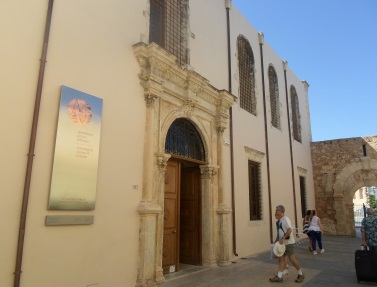|
Rethymno Museum |
|||
|
|
This long period of history also includes the world-famous Minoan period on Crete (around the years 2,600 to 1450 BC), a focal point of the Archaeology Museum. The Archaeological Museum mainly exhibits objects from the district (Greek: Nomos) of Rethymno. Today Crete is divided into four districts.
Opening hours Archaeological Museum Rethymno: According to our information, the collection is now open daily from 8 a.m. to 5 p.m., whereas the museum used to be closed on Mondays. Only on some important holidays the exhibition is closed (e.g. Christmas or Easter (Sunday). Entrance fee Archaeological Museum Rethymno: The entrance is very cheap. It costs only 3 Euro per person. Students, children etc. pay only 2 Euro (April 2017). On public holidays and some other days such as 18 May (International Museum Day) admission is free. Location and buildings: The museum is housed in a building belonging to the Church of Saint Francis (St. Francis or Saint Fransesco Church). One goes through the big city gate (Megali Porta) into the old town Rethymno. Take the second street to the left. After 10 metres you are in front of the entrance of the Archaeological Museum of the third largest city of Crete. The street is called Govatzidaki. Only a few meters from the "Archaeological Museum of Rethymno" is the large central square Mikrasiaton Square. Also the Neratzes Mosque with the minaret and the historical museum are less than 100 meters away. Walking tour through the museum: If you walk counterclockwise through the only large room, you start with prehistory, i.e. the Stone Age. You can see stone tools and other objects from this epoch. The Minoan period begins with the so-called prepalatial period, followed by the actual Minoan epoch, which ends around 1450 BC. Many of the Minoan artifacts in the collection come from a Minoan cemetery in Armeni, a village only 10 km from Rethymnon. Large objects from the Minoan period in the Archaeological Museum in Rethymno are stone coffins (sarcophagi). Besides you can see objects like clay vessels, bronze objects and much more. From the Hellenistic and Roman times, ceramics, jewellery, clay vessels, coins, tools and weapons are exhibited. Of particular interest are the two gravestones and several life-size sculptures. Among them is a very beautiful and well-preserved sculpture depicting Aphrodite, the Greek goddess of love. Other exhibits date from the Byzantine period on Crete. Impression: The Archaeological Museum in Rethymno is not very large. Depending on your interest, you will have seen everything after 10 minutes to an hour. However, some of the objects are interesting. As the collection only costs two Euros entrance fee, a visit to the museum is worthwhile in any case, if one is just nearby. Note: It is planned that the museum will return to the old building not far from the entrance to the great fortress after a renovation. However, the conversion has not yet begun (as of September 2016). It is possible that the exhibition will remain in the church of St. Francis for several years. English Name: Archaeological Museum of Rethymno Greek name: Αρχαιολογικό Μουσείο Ρεθύμνου (Archeologiko Museo Rethyimno) Map Rethymno Crete
Search for more information on this website:
|
||
